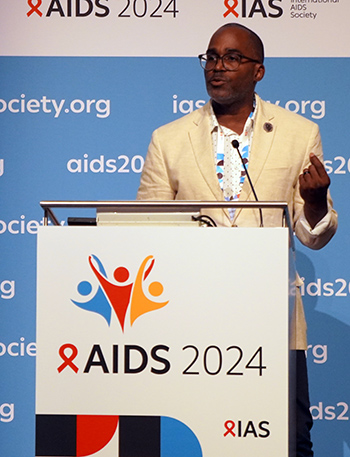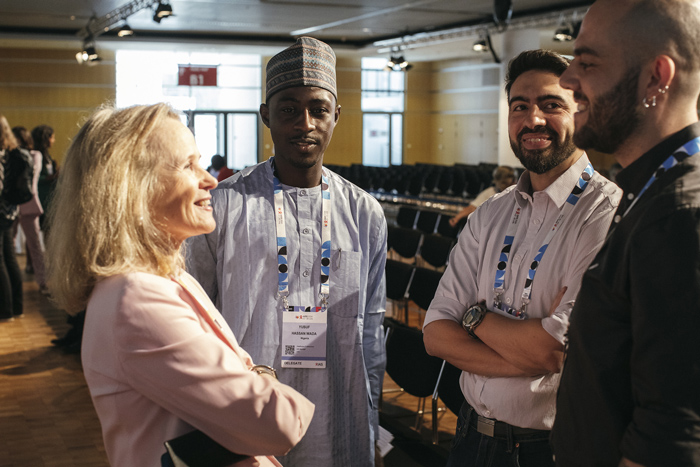New Research Frontiers and Funding Fears
Reports of progress at the 25th International AIDS Conference tempered by diminishing financial resources
By Robert Kessler

It was very much a tale of highs and lows as thousands gathered in Munich, Germany, for the 25th International AIDS Conference (AIDS 2024), the world’s largest biannual gathering of HIV scientists, activists, and industry representatives. Throughout the week, grim reporting about the future of funding for HIV programs was juxtaposed with promising research data illuminating a difficult but clear path forward.
UNAIDS released its annual report on the state of the epidemic on the first day of the conference. In 2023, there were 39.9 million people living with HIV worldwide, with 1.3 million new infections and 630,000 AIDS-related deaths. This shows progress, but nowhere near the rate necessary to meet both 2025 and 2030 targets. An estimated 86% of people living with HIV are aware of their status, 89% of those diagnosed are being treated, and 93% of those have achieved viral suppression, falling short across the board of the 95-95-95 targets, in which all three metrics are at 95% or higher.
Funding remains the critical barrier to achieving success. According to UNAIDS, there was US$19.8 billion available for the global HIV response at the end of last year, $9.5 billion less than necessary. At the same time, a new report from Funders Concerned About AIDS shows philanthropic funding for HIV was down 6% in 2022. As world governments have threatened to pull back from global efforts like the Global Fund and PEPFAR, the much-heralded progress of the past two decades in particular may be in jeopardy.
But despite these threats, in session after session researchers and advocates alike hailed the results of groundbreaking studies in treatment and prevention. The most widely discussed was the PURPOSE 1 trial, testing the antiretroviral lenacapavir, given by injection twice a year, as HIV prophylaxis for cisgender women and girls. The study, conducted in Uganda and South Africa, showed 100% efficacy and its presentation in a Wednesday morning plenary was met with a standing ovation.
Other highlights included yet another HIV cure through stem cell transplantation; two studies on the use of the antibiotic doxycycline to prevent STIs, known as doxyPrEP; and the promise of broadly neutralizing antibodies (bNAbs), which amfAR has invested in heavily recently.

The theme emerging in each of these cases is choice. amfAR CEO Kevin Robert Frost has long said that there’s unlikely to be one catch-all cure for HIV, but rather that first we’ll cure “some people some of the time, then cure more of the people more of the time, and eventually most of the people most of the time.” This seems likely to be a winning strategy when it comes to the prevention and treatment of HIV as well. While some may prefer the daily pills that are generally available now, others may prefer the discretion or convenience of long-acting injectables.

What won’t work, it seems clear, is if individual people are forced to make that choice based on availability or cost alone. The research may be promising, but it won’t make any difference at all if effective medications are only available to some people in some parts of the world. While lenacapavir PrEP won’t be approved for use until the results of the PURPOSE 2 trial, which is ongoing, lenacapavir for HIV treatment currently costs about $40,000 per year. That cost is particularly stunning given another study presented by UNAIDS at the conference that found it could be made and sold for $40 a year and still maintain a 30% profit for its creator, Gilead. Gilead said it was “too early” to price lenacapavir for prevention, as it was awaiting clinical trial data and potential regulatory filings, but promised “a strategy to enable broad, sustainable access globally.” A drug that’s demonstrated 100% efficacy won’t reach its full potential as long as those most in need of it are priced out.
As UNAIDS executive director Winnie Byanyima said during the conference, “We are only six years away from 2030 and we still have 1.3 million new HIV infections per year. We want this miracle prevention to reach all those who need it now, not in six years’ time.”
Robert Kessler is amfAR’s Program Communications Manager.
Share This:
